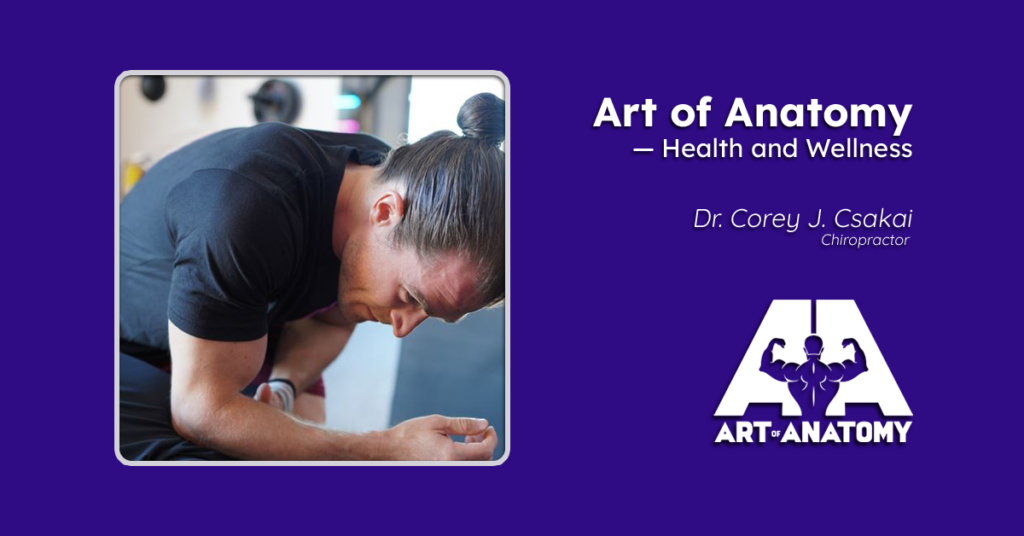Health and Wellness
Body Work
by Dr. Corey J. Csakai
Chiropractor

Page Contents

Introduction
Welcome to Art of Anatomy: Health and Wellness. My name is Corey J. Csakai, DC, and I am the owner of Art of Anatomy. As a provider, my specialty is the assessment and treatment of connective tissue, namely fascia.
Fascia is a broad category of connective tissue, and it is the most valuable tissue in the human body for both structure and function. Nearly all physical ailments—pain, tightness, stiffness, dysfunction, imbalance, etc.—are caused by or exacerbated by issues with fascia.
Treatments with me will include exactly what you need—nothing more and nothing less. Instead of the cookie-cutter treatments you may experience at other clinics, your treatment with me is individualized, and 100% of your time will be spend with me, your provider.
Booking
Click/tap any of the following treatment options to learn more or to book your appointment.
Chiropractic adjustments
Standard treatment
Therapeutic massage
Stretching
“Pump” treatment
Please read the descriptions prior to booking. Errors in booking selection may interfere with your appointment (e.g., if you book a 45-Minute “Pump” Treatment but intended to book the 60-Minute option, you may not get 60 minutes if others have booked after you).
Chiropractic adjustments
Chiropractic adjustments—commonly described as “cracking” joints—may help to reduce stiffness, improve mobility, reduce pain, and restore function. Adjustments may include any/all of the following. As the patient, it is your right to choose which adjustment(s) you receive.
- Spinal adjustments: neck, midback, lower back
- Pelvis: sacroiliac (SI) joints and pubic symphysis
- Extremities: hips, ankles, shoulders
Standard treatment
If you’re experiencing pain or discomfort, tight muscles, restricted movement, numbness/tingling, or any other physical ailments including injury, book a standard appointment for assessment and treatment. Treatments may include fascial manipulation, stretching, exercise, and/or chiropractic adjustments.
Therapeutic massage (with optional adjustment[s])
For 30 or 60 minutes*, this is a unique massage-like therapy (fascial manipulation) to release tension and restriction within the fascia, caused by densifications, which are often the cause of tightness in muscles, stiffness in joints, and pain throughout the body.
*Although not required, it’s recommended 60 minutes for full body and 30 minutes for a smaller region (e.g., upper body vs. lower body). Please do not book therapeutic massage for injuries or ailments and instead use Standard treatment.
Stretching (with optional adjustment[s])
Full-body stretching:
- Neck (including upper trapezius)
- Chest (pectoralis major)
- Latissimus dorsi
- Lower back
- Glutes (gluteus maximus and gluteus medius)
- Quadriceps
- Hamstrings
- Hip adductors
“Pump” treatment [with optional adjustment[s])
The pump treatment is for anyone who wants to enhance their muscles’ pump following a workout. The treatment consists of fascial manipulation to improve fascial mobility and allow your muscles to become pumped with less restriction. Check out the Pump Treatment highlight on Art of Anatomy Instagram account to see some results!
Recommendation:
— 45 minutes: chest, shoulders, arms, glutes, hams, or calves.
— 60 minutes: quads, back, or a combination of 2 smaller groups (e.g., hamstrings/calves, chest/arms, etc.)
As a patient at Art of Anatomy, you will never:
If you select a 30-minute treatment, you can expect to be treated for 30 minutes. Likewise, if you choose a 60-minute treatment, you will be treated for a full 60 minutes. Additionally, my goals are aligned with yours: I want you to feel better so you do not need to come back!
More About Fascia
Fascia is a broad category of connective tissue primarily comprised of collagen with a ground substance of hyaluronic acid. The Fascia Research Congress has offered a much more specific and scientific definition:
The fascial system consists of the three-dimensional continuum of soft, collagen containing, loose and dense fibrous connective tissues that permeate the body. It incorporates elements such as adipose tissue, adventitiae and neurovascular sheaths, aponeuroses, deep and superficial fasciae, epineurium, joint capsules, ligaments, membranes, meninges, myofascial expansions, periostea, retinacula, septa, tendons, visceral fasciae, and all the intramuscular and intermuscular connective tissues including endo-/peri-/epimysium.
The fascial system surrounds, interweaves between, and interpenetrates all organs, muscles, bones and nerve fibers, endowing the body with a functional structure, and providing an environment that enables all body systems to operate in an integrated manner.
Fascia Research Congress: via Stecco C, Adstrum S, Hedley G, Schleip R, Yucesoy CA. Update on fascial nomenclature. Fascia science and clinical applications: letter to the editor. 2018;22(2):354.
As explained in the definition above, fascia includes all connective tissue that has a role in your body’s structure, function, or both. Without fascia, you would have neither structure nor function: your bones would not connect to each other, your muscles would not connect to your bones, and all other body systems would be directly affected without the existence of fascia.
Likewise, if your fascia is not healthy, you will absolutely experience issues with body structure and/or function; you may experience chronic pain, generalized dysfunction, muscle tightness, joint stiffness, neuropathy, muscular or postural imbalance, tendinopathy, or nearly any other physical health complications. Learn about fascial manipulation and schedule your first or next visit!
Treatments: What to Expect
Click any of the headings below to learn more about the specific procedure.
Treatment Pricing
Payment options include: Zelle, Venmo, Cash, Credit (HSA cards accepted)
To learn more about common ailments treated, tap/click here. To learn about the types of service provided during treatment sessions, tap/click here.
Chiropractic adjustments: $25
Standard treatment
—30 minutes: $60
—60 minutes: $110
Therapeutic massage
—30 minutes: $45
—60 minutes: $85
Stretching: $45
“Pump” treatment
—45 minutes: $65
—60 minutes: $85
Ailments Treated
Disclaimer
The following information is for educational purposes only and is not intended to replace the advice of your doctor, even if you are an established patient of Art of Anatomy. Corey J. Csakai, DC and Art of Anatomy disclaim any liability for the decisions you make based on this information.
The information contained on this website does not establish, nor does it imply, doctor-patient relationship. Corey J. Csakai, DC and Art of Anatomy do not offer this information for diagnostic purposes. A diagnosis must not be assumed based on the information provided.
Fascial ailments include nearly all physical ailments; therefore, if something is wrong, there is a good chance your fascia is directly or indirectly involved. However, regardless of whether or not fascia is involved, below you will find a list of ailments commonly treated at Art of Anatomy including descriptions of each.
Click any of the headings below to learn more about the ailment.
Page Contents
Hours
Monday – Thursday
9 AM – 7 PM
Friday – Saturday
9 AM – 3 PM
Connect
Email:
contact@artofanatomy.fit
